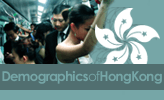Bilingualism in Hong Kong
 |
| Demographics and Culture of Hong Kong |
|---|
| Demographics |
| Culture |
| Other Hong Kong topics |
|
|
Hong Kong is an officially bilingual territory. Under the Article 9 of the Hong Kong Basic Law and the Official Languages Ordinance, "English and Chinese" are, of equal status, the official languages of the territory.[1] However, it is not specified which variety of "Chinese" is referred to. While Mandarin written in simplified Chinese characters is used as the standard language in mainland China, Cantonese in traditional Chinese characters is the de facto standard in Hong Kong.
Chinese as an official language
Cantonese, the language of Canton (now called Guangdong) and other parts of southern China became an official language of Hong Kong when the Chinese population of the colony grew. Hong Kong's population reached 6.99 million in 2006,[2] of which approximately 95% are of Chinese descent, the majority of which was Cantonese, Hakka, and Teochew.
English as an official language
Hong Kong became a crown colony of the United Kingdom in 1840, and was established as a free port to serve as an entrepôt of the British Empire. The government officials and businessmen from Britain spoke English. The British administration in Hong Kong continued to use English as an official language, but added Chinese (Cantonese) as another official language in 1974.
Following the 1997 transfer, English is still widely used in law and business, and it is still taught in kindergartens, primary schools, secondary schools, and universities. The British have also left their language on place names within Hong Kong, particularly on Hong Kong Island, where British rule had the largest impact.
Code-switching in Hong Kong
Code-switching, or the practice of using more than one language in conversation, is very common in Hong Kong. It usually involves a mix of Cantonese and English as a result of the bilingualism in Hong Kong.
Other languages in Hong Kong

Hong Kong is home to a wide range of ethnicities, and substantial portions of Hongkongers are neither native English nor native Cantonese speakers. Japanese is the largest non-official language, with over 25,000 Japanese people in Hong Kong. Vietnamese refugees emigrated to Hong Kong following the Vietnam War starting 1975 [3] and intensified following the Sino-Vietnamese War of 1979[4][5] and still speak Vietnamese as their first language.
There is a significant number of South Asians in Hong Kong. Signboards written in Hindi or Urdu are common in areas with South Asians, and languages such as Nepali, Sindhi and Punjabi are often heard on the streets of Hong Kong as well.
In addition, the large number of domestic helpers[6] from Indonesia [7][8]and the Philippines [9][10]made Indonesian and Tagalog significant minority languages in Hong Kong.
There are also two newspapers written in Nepali in Hong Kong, The Everest and the Sunrise Weekly Hong Kong. In 2004, the Home Affairs Bureau and Metro Plus AM 1044 jointly launched radio shows Hong Kong-Pak Tonight in Urdu and Harmo Sagarmatha in Nepali.[11]
See also
References
- ↑
- ↑ "Hong Kong Statistics - Population and Vital Events", Census and Statistics Department. Retrieved 2007-02-02
- ↑ 逾千越南難民獲發港身份證 (in Chinese). Apple Daily. Retrieved 17 August 2014.
- ↑ "About Us". The UNHCR Sub-Office Hong Kong SAR web-site. Retrieved 17 August 2014.
- ↑ 寶玲, 王. 越南難民,何來何往? (PDF) (in Chinese). Retrieved 17 August 2014.
- ↑ "Foreign domestic workers in Hong Kong". SCMP. Retrieved 17 August 2014.
Foreign domestic workers make up around 3 per cent of the Hong Kong population. In 2013, there were some 320,000 foreign domestic helpers in Hong Kong, of which 50 per cent were from the Philippines, 47 per cent from Indonesia, and the rest from Thailand, Myanmar, Bangladesh, Nepal, Pakistan and Sri Lanka.
- ↑ "The Demographics : Ethnic Groups". GovHK. Race Relations Unit, Home Affairs Department, Hong Kong Government. Retrieved 17 August 2014.
- ↑ "Foreign domestic workers in Hong Kong". SCMP. Retrieved 17 August 2014.
Foreign domestic workers make up around 3 per cent of the Hong Kong population. In 2013, there were some 320,000 foreign domestic helpers in Hong Kong, of which 50 per cent were from the Philippines, 47 per cent from Indonesia, and the rest from Thailand, Myanmar, Bangladesh, Nepal, Pakistan and Sri Lanka.
- ↑ "The Demographics : Ethnic Groups". GovHK. Race Relations Unit, Home Affairs Department, Hong Kong Government. Retrieved 17 August 2014.
- ↑ "Foreign domestic workers in Hong Kong". SCMP. Retrieved 17 August 2014.
Foreign domestic workers make up around 3 per cent of the Hong Kong population. In 2013, there were some 320,000 foreign domestic helpers in Hong Kong, of which 50 per cent were from the Philippines, 47 per cent from Indonesia, and the rest from Thailand, Myanmar, Bangladesh, Nepal, Pakistan and Sri Lanka.
- ↑ "Urdu and Nepali radio programmes to launch". Hong Kong Information Services Department. 2004-11-19. Retrieved 2007-01-12.
